Question 1.
Have you ever touched a magnifying glass with your hand?
Answer:
Yes.
Question 2.
Have you touched the glass in the spectacles used for reading with your hand?
A. Yes.
Question 3.
Is it a plane or curved surface?
Answer:
Curved surface.
Question 4.
Is it thicker in the middle or at the edge?
Answeer:
Magnifying glass and some spectacle are thicker in middle whereas some spectacles are thicker at edge.
Question 1.
A man wants to get a picture of a zebra. He photographed a white donkey after fitting a glass, with black stripes, on to the lens of his camera. What photo will he get? Explain. (AS1)
(OR)
A person wants to get a picture of zebra and he photographed a white donkey fitting a glass with black stripes. Does he get photo of zebra? Explain.
Answer:
The person was unable to gel the picture <>l zebra because only two rays are enough to form complete image after convergence. So he will get the image of white donkey but the intensity may be less.
(OR)
He will get a picture of while donkey because eery part of lens forms an image so if you cover lens with stripes still it forms a complete image. However, the intensity of the image will be reduced.
Question 2.
Two converging lenses are to be placed in the path of parallel rays so that the rays remain parallel after passing through both lenses. How should the lenses be arranged? Explain with a neat ray diagram. (AS1)
Answer:
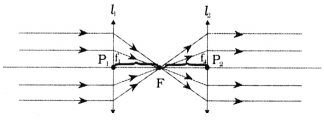
- Two lenses are placed in the path of parallel rays as shown in figure.
- The first lens is placed in the direction of parallel lines, which converges at focus.
- The second lens is arranged so that it is the focus of 2nd then emerging rays will be parallel.
Question 3.
The focal length of a converging lens is 20 cm. An object is 60 cm from the lens. Where will the image be formed and what kind of image is it? (AS1)
Answer:
f = 20 cm (by sign conversion f = + 20 cm)
u = 60 cm (by sign conversion u = - 60 cm)

Image will be formed at 30cm in between F1, and 2F1. Image is real, inverted and diminished.
Question 4.
A double convex lens has two surfaces of equal radii ‘R’ and refractive index n = 1.5. Find the focal length ‘f’. (AS1)
(OR)
What is the focal length ‘f, when its double convex lens has two surfaces of equal radii ‘R’ and refractive index n = 1.5?
Answer:
R1= R2= R (suppose)
Focal length (f) = ?; Refractive index (n) = 1.5

∴ Focal length of lens = Radius of curvature of surface.
Question 5.
Write the lens maker’s formula and explain the terms in it. (AS1)
(OR)
Ravi wants to make a lens. Which formula he has to follow ? Write the formula and explain the terms in it.
(OR)
Write lens formula.
Answer:
Lens maker’s formula:
1/f=(n?1)(1/R1?1/R2)
n = Refractive index of the medium
R1= Radius of curvature of 1 st surface
R2= Radius of curvature of 2nd surface
f = Focal length
Question 6.
How do you verify experimentally that the focal length of a convex lens is increased when it is kept in water? (AS1)
(OR)
Write an activity to show that the focal length of a lens depends on its surrounding medium.
Answer:
Aim :
To prove focal length of convex lens is increased when it is kept in water.
Apparatus :
Convex lens, water, cylindrical vessel, circular lens holder, stone.
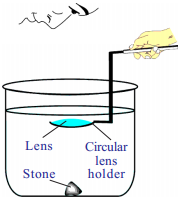
Procedure :
- Take a cylindrical vessel like glass tumbler.
- Its height must be greater than the focal length of lens, (the around four times focal length of lens).
- Keep a black stone inside the vessel at its bottom.
- Pour the water into the vessel such that the height of the water level from the top of the stone is greater than the focal length of lens.
- Now dip the lens horizontally using a circular lens holder.
- Set the distance between stone and lens that is equal to or less than focal length of lens.
- Now see the stone through the lens.
- We can see the image of the stone.
- If we dip the lens to a certain height which is greater than the focal length of lens in air, still we can see the image.
- This shows that the focal length of convex lens has increased in water.
- Thus we conclude that the focal length of lens depends upon the surrounding medium.
Note : For convenience, use 5 or 10 cm focal length convex lens.
Question 7.
How do you find the focal length of a lens experimentally? (AS1)
Answer:
- Take the lens (Ex : Convex), which focused towards the distant object.
- A white coated screen (Ex : White paper) is placed on the other side of the lens.
- Adjust the screen till you get a clear image of the object.
- At this position measure the distance between the lens and screen which is equal to the focal length of the lens.
Question 8.
Harsha tells Siddhu that the double convex lens always behaves like a convergent lens. But Siddhu knows that Harsha’s assertion is wrong and corrected Harsha by asking some questions. What are the questions asked by Siddhu? (As2)
Answer:
The questions asked by Siddhu :
- Is the object placed beyond 2f point?
- Is the object located at 2f point?
- Is the object located in between the 2f and the focal point?
- Is the object located at the focal point?
- Is the object located in front of the focal point?
- Is the lens kept in a medium with refractive index less than lens or more than lens?
Question 9.
Assertion (A): A person standing on the land appears taller than his actual height to a fish inside a pond. (AS2)
Reason (R) : Light bends away from the normal as it enters air from water.
Which of the following is correct? Explain.
a) Both A and R are true and R is the correct explanation of A.
b) Both A and R are true and R is not the correct explanation of A.
c) A is true but R is false.
d) Both A and R are false.
e) A is false but R is true.
Answer:
Answer a is correct.
Explanation :
Because the light travelling from water to air it bends away from the normal so the fish observes the apparent image of the person, appears taller than his original.
Question 10.
A convex lens is made up of three different materials as shown in the figure Q-10. How many of images does it form? (AS2)

- A lens made of three different materials of refractive indices say n1, n2 and n3.
- These three materials will have three different refractive indices. Thus for a given object it forms three images.
Question 11.
Can a virtual image be photographed by a camera? (AS2)
Answer:
Yes, we can.
Ex : - A plane mirror forms a virtual image, we can able to take photograph of that image in plane mirror.
Question 12.
You have a lens. Suggest an experiment to find out the focal length of the lens. (AS3)
(OR)
Through an experiment, find out the focal length of the lens.
Answer:
Aim :
To find focal length of given lens.
Apparatus :
Object (candle), convex lens, v – stand, screen.
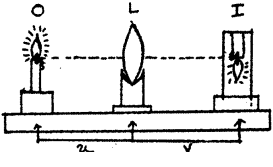
Procedure :
- Take a v-stand and place it on a long table at the middle.
Place a convex lens on the v-stand. Imagine the principal axis of the lens.
- Light a candle and ask your friend to take the candle far away from the lens along the principal axis.
- Adjust a screen (a sheet of white paper placed perpendicular to the axis) which is on other side of the lens until you get an image on it.
- Measure the distance of the image from the v-stand of lens (image distance V) and also measure the distance between the candle and stand of lens (object distance ‘u’). Record the values in the table.

- Now place the candle at a distance of 60 cm from the lens, try to get an image of the candle flame on the other side on a screen. Adjust the screen till you get a clear image.
- Measure the image distance V and object distance ‘u’ and record the values in table.
- Repeat the experiment lor various object distances like 50 cm, 40 cm, 30 cm, etc. Measure the image distances in all cases and note them in table.
- Using the formula 1/f=1/v?1/u, find f in all the cases. We will observe the value ‘f is equal in all cases. This value off is the focal length of the given lens.
Question 13.
Let us assume a system that consists of two lenses with focal length f1, and f2respectively. How do you find the focal length of the system experimentally, when
i) two lenses are touching each other
ii) they are separated by a distance ‘d’ with common principal axis? (AS3)
Answer:
Experimental Proof:
i) Two lenses are touching each other :
Aim :
To find focal length of combination of two convex lenses, touching each other. Material required : Convex lenses – 2 (with known focal lengths say f, and f2); V-stands – 2, candle, screen scale.
Procedure:
- Place two V-stands with two convex lenses as they touch each other on a table.
- Place a candle (object) far away from the lenses.
- Adjust a screen, which is placed other side of the lenses until we get a clear image on it.
- At that position, measure the image distance (v) and object distance (u).
- Do this experiment for several object distances and record in the given table.
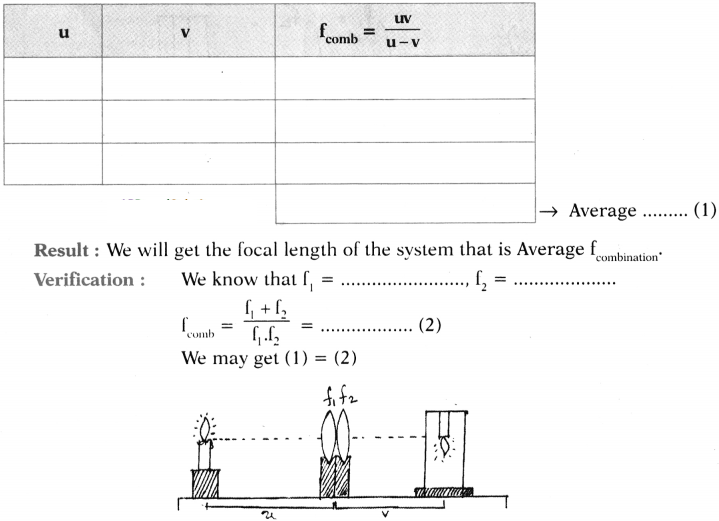
ii) They are separated by a distance of ‘d’ :
Procedure :
- Now place v-stands along with lenses with distance’d’.
- Do the same procedure again.
- Record the observations in the given table.
- Find the average of the ‘f’comb.

Question 14.
Collect the information about the lenses available in an optical shop. Find out how the focal length of a lens may be determined by the given power’ of the lens. (AS4)
Answer:
I had collected the information regarding different lenses available at optical shops.
The relationship between power and focal length is power (D) = 1/f. f is in meters.
| Power of lens in diopters |
Type of lens |
Focal length |
| 0.25 |
Convex |
400 cm |
| 0.5 |
Convex |
200 cm |
| 1 |
Convex |
100 cm |
| -2 |
Concave |
50 cm |
| – 1 |
Concave |
-100 cm |
| -0.5 |
Concave |
-200 cm |
| -0.25 |
Concave |
-400 cm |
Question 15.
Collect the information about lenses used by Galileo in his telescope. (AS4)
(OR)
What lenses are used by Galileo in his telescope?
Answer:
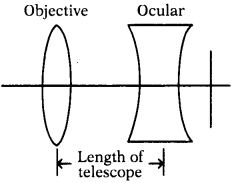
A Galilean telescope is defined as having one convex lens and one concave lens. The concave lens serves as the ocular lens or the eye piece, while the convex lens serves as the objective. The lens are situated on either side of a tube such that the focal point of the ocular lens is the same as the focal point for the objective lens.
Question 16.
Use the data obtained by activity - 2 in table-1 of this lesson and draw the graphs of u vs v and 1/u vs 1/v (AS5)
(OR)
By obtaining data from activity - 2 in table - 1 of this lesson, draw the graphs of u vs v and 1/u vs 1/v
Answer:
Graph of u - v using data obtained by activity - 2. Take lens with focal length 30 cm.
| Object distance (u) |
Image distance (v) |
Focal length (f) |
| 60 cm |
60 cm |
30 cm |
| 50 cm |
75 cm |
30 cm |
| 40 cm |
120 cm |
30 cm |
The graph looks like this
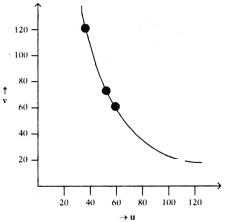
The shape of the graph is rectangular hyperbola. Graph of 1/u - 1/v

For these values the graph is straight line which touches the axis as shown in figure.
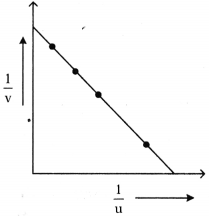
Question 17.
Figure shows ray AB that has passed through a divergent lens. Construct the path of the ray up to the lens if the F position of its foci is known. (AS5)
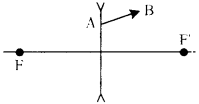
Answer
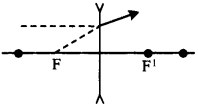
The path of the ray up to the lens if the position of foci is known for ray AB is diverging lens or concave lens path.
Question 18.
Figure shows a point light source and its image produced by a lens with an optical axis N1, N2. Find the position of the lens and its foci using a ray diagram. (AS5)

Answer
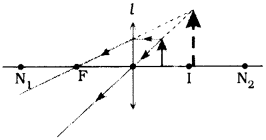
- The object is in between focus and optic centre.
- The image is virtual, erect and magnified. Nv
- l is the lens, ‘O’ is the object and T is the image.
Question 19.
Find the focus by drawing a ray diagram using the position of source S and the image S’ given in the figure. (AS5)

Answer
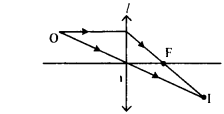
- Image is real.
- l’ is lens, ‘O’ is object and T is image.
- Lens is convex.
(OR)
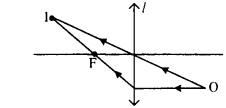
- Image is real.
- l’ is lens, ‘O’ is object and ‘I’ is image.
- Lens is convex.
Question 20.
A parallel beam of rays is incident on a convergent lens with a focal length of 40 cm. Where should a divergent lens with a focal length of 15 cm be placed for the beam of rays to remain parallel after passing through the two lenses? Draw a ray diagram. (AS5)
Answer:
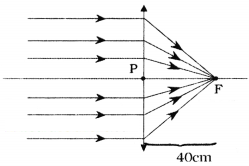
- 1. A parallel beam of rays when incident on a convergent lens, after refraction they meet at the focus of the lens.
- 2. A beam of rays which is incident on a divergent lens, after refraction, pass parallel to the principal axis. If we extend these incident rays, they seems to meet at focus of the lens.
- 3. Hence the divergent lens should be kept at 25 cm distance from convergent lens (40 - 15 = 25 cm) as shown in the figure.
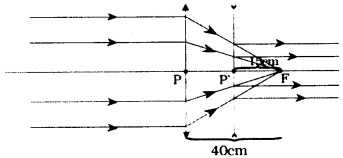
PF = 40 cm (Focal length of convergent lens)
P’F = 15 cm (Focal length of divergent lens)
PP’ = 40 - 15 = 25 cm (Position of divergent lens)
Question 21.
Draw ray diagrams for the following positions and explain the nature and position of image.
i) Object is placed at 2F2
ii) Object is placed between F2and optic centre P. (AS5)
Answer:
i) Object is placed at 2F2:

Nature : Real, inverted and diminished.
Position : Image is formed on the principal axis between the points F1, and 2F1.
ii) Object is placed between F2and optic centre P :
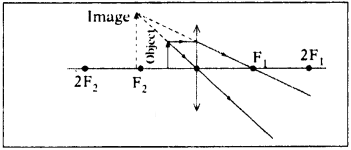
Answer:
- Ray diagrams are very useful in optics.
- By the ray diagrams, we can easily find the values of image distance, object distance, focal length, radius of curvature, magnification, etc.
- These results are exactly equal to the result gotten by an experiment.
- For example : In the experiment, with a convex lens, we get clear image of an object, on a screen by adjusting the screen.
Then, we measure the image distane (v) practically. This takes more time and requires equipped lab also.
But, by simply draw a ray diagram on a paper, we can get exact image distance (v) very easily, without lab.
- So, ray diagrams are very useful in the construction of microscopes, telescopes, etc.
- Hence, one can trust and depend on the result of ray diagrams instead of several lab experiments.
- So, I appreciate the ray diagrams.
Question 23.
Find the refractive index of the glass which is a symmetrical convergent lens if its focal length is equal to the radius of curvature of its surface. (AS7)
Answer:
Given that lens is convergent symmetrical
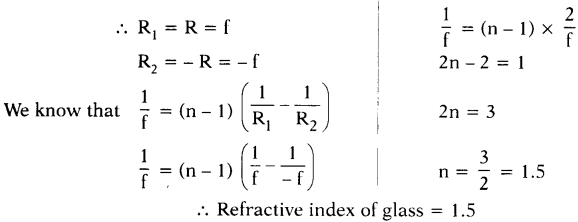
Question 24.
Find the radii of curvature of a convexo - concave convergent lens made of glass with refractive index n = 1.5 having focal length of 24 cm. One of the radii of curvature is double the other. (AS7)
Answer:
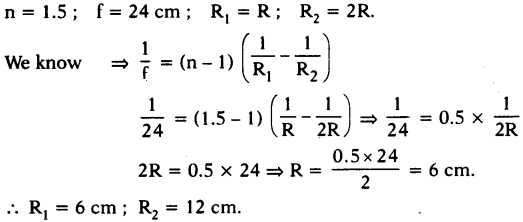
Question 25.
The distance between two point sources of light is 24 cm. Where should a convergent lens with a focal length of f = 9 cm be placed between them to obtain the images of both sources at the same point? (AS7)
Answer:
For Source S1:
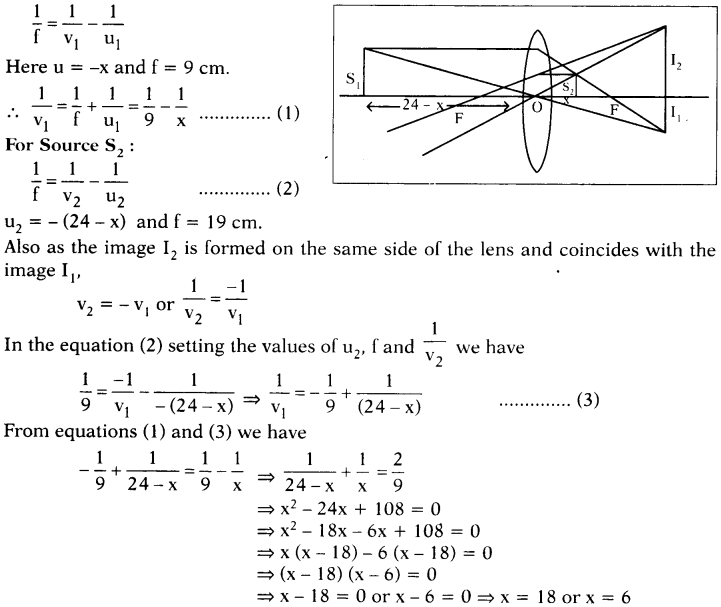
∴ The convex lens may be placed between the two sources, such that a distance of 18 cm from one source, and 6 cm from other source.